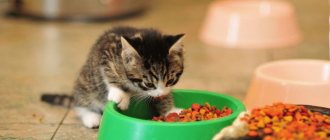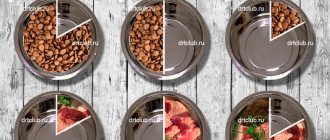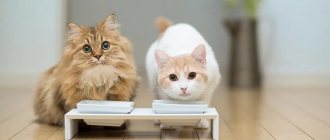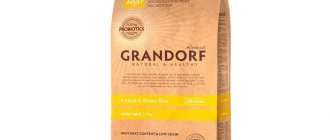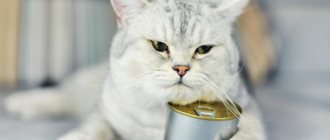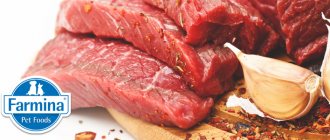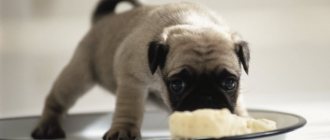When choosing the most optimal way to switch your cat to another food, you should not expect that she will immediately start eating it. Many mustachioed pets are picky eaters, especially at an older age, and suffer from food allergies and other diseases. But no matter for what reason the food changes: whether the kitten is growing up, the usual brand has disappeared from sale or has risen sharply in price, supply interruptions, only a gradual transition will provide a chance for success.
Why do difficulties arise?
Any animal gets used to food. Especially if the cat has been given only one food for many months, and he has not seen any alternatives. You can’t come to an agreement with your pet, so you have to use tricks to accustom him to food that is unusual for him.
The unfamiliar texture, smell and taste of a new treat can cause a negative reaction in the animal. You will have to be patient and not give in to provocations: ignoring the bowl, “burying” granules of new food, loud meowing, meaning a demand to immediately fill the bowl with the usual food, “hungry eyes.”
Gradual translation
A smooth transition from one food to another is the most effective and safest method. The essence of this method is to gradually add new food to the old and mix them. This gradual transition may take about 10 days.
On the first day, you should mix the animal’s familiar and new food in a 3:1 ratio.
If everything in the bowl has been eaten, the next day you can increase the share of the new diet. By the fifth day, the amount of new food should be increased to 50%. After a week and a half, the cat will eat the new food with appetite, even if there is not a crumb of the old food on the plate.
It happens that the period of gradual transition is delayed: the animal eats the entire portion only if more than half of it is its favorite food, and when new food is added in larger quantities, it refuses to eat. This may indicate that the gentle technique is not suitable and other measures are needed.
Animal disease
Like all living organisms on this planet, cats age and there is a risk of developing various diseases, including obesity. To avoid this, you need to choose a diet with a lower calorie content. It is better not to use food with a high protein content for an aging animal.
There are diseases for which the animal needs to adhere to a special diet. There are special medicinal foods, but in no case should you select them yourself. A veterinarian will advise you individually on how to switch a cat to another food and which one to choose in this case.
Reasons for changing your diet
The reasons why you need to switch your cat to a different diet may be the following:
- transition of an animal to another age group. A kitten, an adult cat and a cat or an already aging pet have their own nutritional requirements. Therefore, as your pet gets older, the need to change its diet will arise at least twice;
- cat pregnancy. In this state, the female needs more vitamins and nutrients into her body. Experts recommend switching pregnant cats to special food;
- postoperative recovery period (for example, after castration and sterilization). During rehabilitation, the risk of your pet gaining extra pounds increases. Therefore, veterinarians prescribe special food for animals;
- the pet has an individual intolerance to any product or component. This condition is characterized by the development of food allergies, which requires careful selection of food;
- disease. The disease weakens the pet, so he must follow a special diet prescribed by the veterinarian. In this case, independent selection of food is prohibited;
- Your pet's favorite food has been discontinued.
Some breeders recommend changing your cat's food 3 times a year to reduce the risk of developing food allergies. But if the animal feels normal and does not suffer from digestive disorders, then you can refrain from such actions.
The main thing is patience
How to properly switch a kitten to dry food depends on its previous diet. In any case, the transition should be gradual and carried out within two weeks. Some pets immediately pounce on the offered treat, while others need time to get used to it.
If the kitten has already appreciated the food from the table, in the first days of transfer you should add a few granules from the pack to the usual food. Slowly, day after day, the amount of ready-made food increases and completely replaces the previous diet.
It happens that the pet simply leaves the “drying” and eats its usual food. In this case, experienced breeders recommend slightly moistening the granules.
Feed requirements
When choosing a new type of food for your domestic cat, you must adhere to the following requirements:
- composition and calorie content. The composition of new food products should include all micro- and macroelements, as well as vitamins that an animal of a particular age needs for growth and development;
- manufacturer. It is better to give preference only to well-known and time-tested manufacturers;
- shelf life;
- price. The owner should be able to purchase a new food format.
Feed change stages
Veterinarians do not recommend switching exclusively to homemade food, since it does not meet all the needs of the pet’s body.
In order for the pet to get used to the new food, it is necessary to gradually increase its share in the old one.
To correctly transfer a cat to a new product, you should follow the system shown in the table:
| Days of product introduction | Ordinary (%) | New (%) |
| 1—3 | 75 | 25 |
| 4—8 | 50 | 50 |
| 9—12 | 25 | 75 |
| 14+ | No | 100 |
How often should you feed a kitten?
Feeding kittens must be properly organized. It is very important that the kitten is always full, but does not overload its digestive system. Overfeeding can cause digestive upset, disrupt metabolism, cause diarrhea, and systemic disruptions in the body.
By the age of two months, a kitten should eat five to six times a day. This is due to the fact that their small tummy is not able to accommodate much food. In addition, we should not forget that the gastrointestinal tract is not completely populated with beneficial microorganisms responsible for digestive processes. Therefore, kittens should be fed in small portions. Food is given at the same time.
When the kitten grows a little and reaches the age of three months, the frequency of feedings can be reduced to four times, while slightly increasing the portion of food or ready-made food.
When the kitten is six to seven months old, the frequency of feedings is gradually reduced to three times a day. At the age of 8–9 months, you can switch your pet to two meals a day.
Switching to another food after a “hunger strike”
You can, of course, immediately give the animal new food, in 90% of cases the cat will simply refuse the new food, and this can also lead to an upset stomach and vomiting. So how can you correctly switch a cat to another food so as not to injure the animal or cause damage to the pet’s gastrointestinal tract?
We invite you to familiarize yourself with the Russian Blue cat breed photo and description, character, similar breeds
To prevent the animal from noticing a sudden change in diet, you need to add new food to the cat’s usual food in small portions for 10 days. This way you can check if your cat is allergic to a new food. If the animal has responded well to the new food and eats it with pleasure along with the old one, then you can gradually, by adding new food in small portions, remove the old food from the diet. On average, such a transfer is completed in 3-4 weeks. If the cat tolerates the new product well, the transfer time can be reduced to 2 weeks.
If for some reason your pet refuses new food, leaving it in the bowl, there is another way to switch your cat to another food, but it may seem very inhumane, although it is very effective. The essence of the method is to temporarily put the cat on a starvation diet.
Having refused a portion of new food, the cat expects that he will now be fed his usual food, but nothing happens. After walking around looking unhappy, the hungry cat again approaches the bowl. After several such approaches, the cat eats the remains of the new food. The next day, we again dilute the favorite food with new food and do not give anything else until the bowl is empty.
This diet is acceptable for 3-4 days. But if the pet continues to refuse new food, you should contact your veterinarian and ask how to switch the cat from one food to another, otherwise the animal may begin to develop a dangerous liver disease, which is fatal.
When switching an animal from natural food to dry food, or vice versa, you can give the cat prebiotics. They will help the gastrointestinal tract adapt to new food faster.
There are times when a sudden change is necessary, for example, when switching an animal to medicinal food, when an intolerance to components of the usual menu appears, or when there is a food allergy. In this case, there is a little trick on how to switch a cat to another dry food, which is to lightly pour fish broth over the dry food.
This will attract the animal's attention. Do not forget to constantly monitor the condition of your pet, its behavior, appearance, so that there are no negative reactions. If any symptoms appear, contact your veterinarian immediately. A timely visit to a specialist will help preserve the life and health of your pet.
We suggest you read: What to feed your Bengal cat?
The most effective way to still achieve success is to give your cat preventative fasting. Naturally, this is not done for the purpose of “punishment,” because there are no monsters or sadists among us, but only for the benefit of the animal. But if suddenly seditious thoughts arise in your head, pushing you to capitulate into the clutches of a tailed tyrant, then remember: not a single cat has ever died from exhaustion in front of a bowl full of food.
Remind yourself often that cats, especially indoor and sterilized ones, even benefit from fasting fasting days - they help prevent them from gaining excess weight.
So, the essence of the procedure is simple: remove the bowl for a day and do not give the cat any food, even if she really asks for it. The next day, place a bowl with new food. Many advise at this moment not to embarrass the animal and not to stand around it with the whole family waiting for a “miracle” - a proud tailed animal may not like public admission of defeat in the war for food.
In general, the period of transfer to another diet using fasting depends on the stubbornness of a particular representative of the cat family, but should not exceed three days, otherwise there is a risk of harm to the health of the animal. Remember that the cat must have access to water at all times.
Transition rules
In order to transfer an animal to a new diet without consequences, it is necessary to adhere to certain rules for the transition. Moreover, in the case of dry food and natural food, there are some nuances.
Something else interesting: Additives in artificial cat food
Dry
When choosing such food, you should give preference to super premium and premium class. The transition is completed within 7–10 days. The animal must be healthy, not pregnant, playful and have regular bowel movements. It is not advisable to switch pets who drink little water to dry food. Otherwise, problems with the bladder and kidneys may occur.
On the first day of changing your diet, you can ignore the dosage. In the first two days, the new food comes as supplements (10–15 “crackers”) to the old diet. It is necessary to soak the dry food a little. Remember that from this time on, your pet should always have enough water. On this diet, the cat will drink 4 times more water!
With each subsequent day, you need to double the dosage of soaked food, while simultaneously reducing the previous diet. By day 10, you should completely change the type of food. A single dosage depending on the age of the pet is indicated on the package.
After switching to dry food, the cat can no longer be fed with natural food or vitamin supplements.
To natural
There are situations when a cat needs to be switched to natural food. Several methods can be used to make this transition.
The forceful method involves stopping the distribution of dry food. In this case, the animal should be offered foods that are easy to digest (offal, boiled chicken meat, cottage cheese), since the previous diet “weaned” the stomach and intestines from proper enzymatic digestion. Food is given in cut pieces, which should be identical in size to dry food. The disadvantage of this method is that the pet may be stubborn and simply go on a hunger strike. In this case, the cat may develop health problems (especially with the liver).
The persuasion method involves gradually reducing the dose of dry food and offering the pet some treats. The choice of treats depends on the individual preferences of the animal. As a result, without unnecessary stress for the cat, it can be gradually switched to natural products.
Something else interesting: Can kittens be given milk?
The mixing method involves adding canned meat to dry food. Gradually the second component should become dominant. You can also gradually introduce vegetables into your diet. The disadvantage of this method is the duration of the transition.
Simultaneously with the transfer, you need to give your pet a complex of lacto- and bifidobacteria or special enzymes. Such supplements will help the intestines restore their function faster.
What not to do
When transferring a pet to a new food format, you should not mix certain types of food (indicated on the product label), or force the animal to eat new food. The cat may independently refuse the new diet, preferring to go on a hunger strike. Without food, a cat can live for three days, after which disturbances in the liver (lipidosis) will begin or gastrointestinal tract disruption will occur, which can lead to death.
It is also prohibited to change the diet at once. The transition had to be smooth, then it would go smoothly and unnoticed by the pet.
The transfer of domestic cats to a new food format should always be carried out according to the rules described above. This is the only way to keep your pet healthy.
Little tricks
When switching your cat to natural food, be sure to give him probiotics, this will help digestion and make the transition easier. Probiotics can be bought at a veterinary pharmacy, but it is better to first ask your veterinarian which drugs are best for your cat. We suggest you read: How to choose a dog breed: the best small one for an apartment according to its characteristics, suitable for a private home, the first one for a child, small one for a beginner
When giving natural food, remove it after 20 minutes, no matter whether the cat has eaten or not.
During the transition and beyond, always give your cat vitamins. It’s best to ask your veterinarian which vitamins are right for your cat.
Tips for feeding cats
Experienced veterinarians identify several basic rules when feeding cats:
- There is no need to mix dry food and canned food in one feeding.
- 2If the animal is fed on feed, it must be premium. Feeding an animal with expensive food is many times cheaper than spending money on treatment after using cheap analogues.
- There is no need to get carried away with wet food - if used frequently, they provoke obesity. They go as a dessert, sometimes you can pamper your beloved pet, but nothing more.
- Dry food lovers should always have a bowl of clean drinking water. Wet food consists of 70% water, but dry food contains much less water. In order for the animal to receive adequate nutrition from dry food, it needs to drink a lot. If a cat doesn't drink enough water, it will affect its well-being. If the condition worsens, you should urgently show the animal to a veterinarian.
- Without compelling reasons, there is no need to change feed frequently, and if this is a necessary measure, then follow the rules outlined above.
- Do not feed food strictly according to the norms indicated on the box. The cat will eat as much as she needs, she will leave the excess in the bowl, but starvation leads to a number of diseases.
- If you feed your cat natural products, then do not forget to add vitamins and minerals to the diet.
A veterinarian will help you perfectly balance your animal’s diet.
Can a cat get tired of food?
Cats, unlike us, are not upset by monotonous food; on the contrary, they get used to one food and can happily eat it every day, provided that the food is of high quality and the pet likes it.
To pamper your pet, you can add various treats to the diet, this is enough.
Why change food at all?
I think everyone has at least once experienced switching a cat to another food; there may be several reasons for this.
- Food quality
Milled economy-class food is not the best option for a cat’s health; it should be replaced with something else. Of course, there are cats who have been eating Whiskas for years, but it’s better not to take risks, pay attention to the composition of the food and reviews, so you can choose the right option.
My husband’s relatives had a Siamese cat, she was fed cheap food, by the age of two her hair began to fall out in bald spots, her teeth deteriorated, the owners were going to euthanize her. My husband’s grandmother took the cat in, changed her diet and her health improved, all the problems were due to her diet.
Our cats used to eat Royal Canin, a veterinarian recommended it a long time ago, since they are neutered and require a balanced diet. But a few years ago we started producing food and the composition underwent changes, so we had to switch the cats to super-premium Brit. The transfer took place reluctantly, but the fluffies got used to it.
- Age
With age, the needs of a cat's body change, in some cases it is necessary to switch to a diet for older animals. - For health
If a pet requires a diet for medical reasons, they are also sometimes switched to special food.
Authorized Products
Small animals allowed on the menu:
- Meat – served raw, boiled or scalded with boiling water. Only low-fat varieties are suitable. Meat products should make up from 60 to 80% of the total daily food intake.
- Liver – no more than 2 times a week.
- Porridges – any are suitable, except semolina. All kittens are not fans of cereals, but they contain many substances that the growing body needs. It is recommended to mix meat and porridge in a ratio of 2 to 1.
- Vegetables - any, except potatoes, served boiled or raw.
- Chicken eggs - small pets can only be given the yolk. Its consumption is also allowed in raw form, but not more than once every 7 days. The yolk of quail eggs can be consumed simultaneously with the white.
- Fermented milk products - any, but with a minimum percentage of fat content. The exception is sour cream; giving it to kittens is strictly prohibited.
- Oil – not vegetable oil, but Vaseline is recommended.
- Brewer's yeast - affects the coat of a small pet.
It is recommended to give your kitten an apple as a fruit.
How to prepare natural food for a cat for a month
Soups, broths, milk are not food for predators who are used to gnawing and chewing. Cats living in villages eat small rodents, birds, fish, insects, and sometimes fresh grass.
Soups, broths, milk are not food for predators who are used to gnawing and chewing
This diet replenishes the cat’s body with essential nutrients.
The home diet should contain:
- Proteins (50%). This is raw lean meat and fish, cottage cheese, fermented milk products, as well as liver, stomachs, and heart. Meat and fish products should be frozen to prevent the animal from becoming infected with parasites.
- Fats (35%). They are found in meat, and sources of vegetable fats can be wheat and corn.
- Carbohydrates (10%). Porridge, vegetables, fruits.
- Food additives (5%). Bone meal, oils, vitamins. Sources of vitamins will be fresh fruits, legumes, and green grass. You can purchase vitamin complexes in veterinary pharmacies, but strictly as prescribed by a specialist. The addition of bifidobacteria will contribute to the restructuring of digestion.
Food in the form of minced meat is not suitable for cats - they swallow meat in pieces according to their size. This does not harm the animals - this is their physiology.
You can add a little chopped lettuce, broccoli, pumpkin, beets, zucchini, and carrots to the finely chopped meat. Taboos for cats are eggplants and tomatoes in any form. These vegetables can lead to food poisoning.
Be sure to read:
Is it possible to feed a cat dry and wet food at the same time: rules, pros and cons

